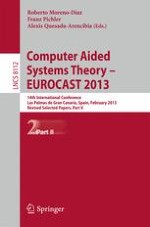The two-volume set LNCS 8111 and LNCS 8112 constitute the papers presented at the 14th International Conference on Computer Aided Systems Theory, EUROCAST 2013, held in February 2013 in Las Palmas de Gran Canaria, Spain. The total of 131 papers presented were carefully reviewed and selected for inclusion in the books. The contributions are organized in topical sections on modelling biological systems; systems theory and applications; intelligent information processing; theory and applications of metaheuristic algorithms; model-based system design, verification and simulation; process modeling simulation and system optimization; mobile and autonomous transportation systems; computer vision, sensing, image processing and medical applications; computer-based methods and virtual reality for clinical and academic medicine; digital signal processing methods and applications; mechatronic systems, robotics and marine robots; mobile computing platforms and technologies; systems applications.
